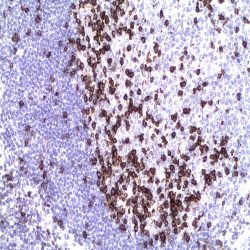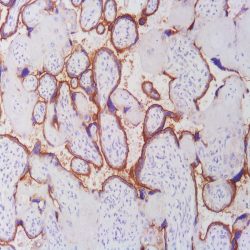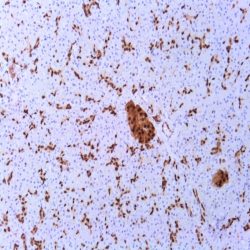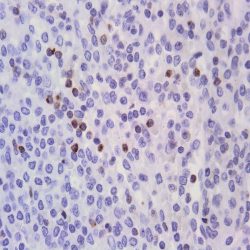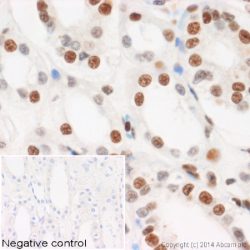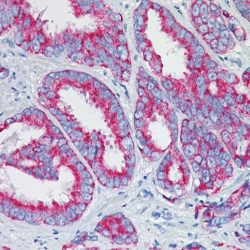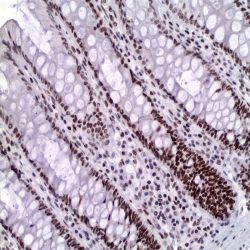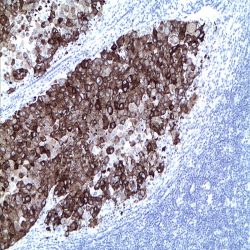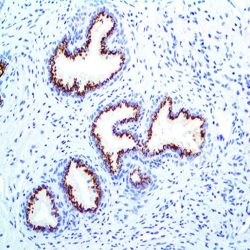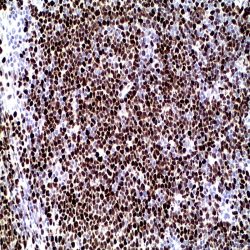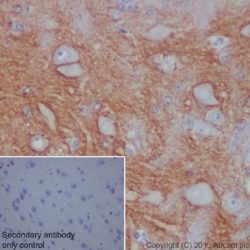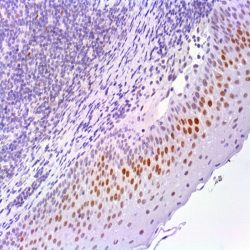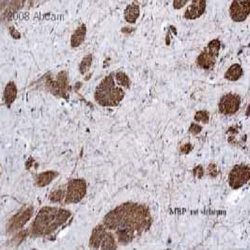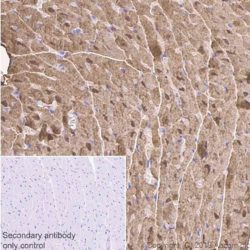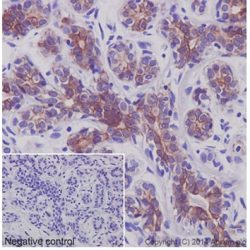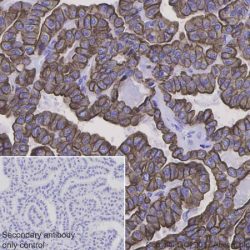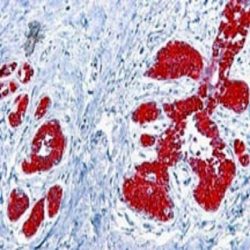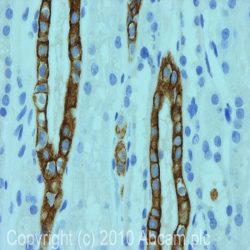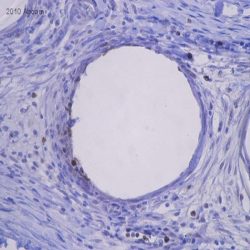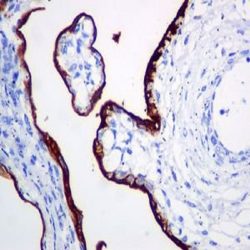ایمونو هیستوشیمی
نمایش 261–280 از 344 نتیجه
فیلتر ها-
آنتی بادیهای ایمونوهیستوشیمی
آنتی بادی PD-1 (NAT105)
امتیاز 0 از 5اطلاعات بیشترName:PD-1 Antibody clone NAT105
Description and aplications: Programmed death-1 (PD-1) is a member of the CD28 family of receptors that includes CD28, cytotoxic T-lymphocyteassociated antigen 4 (CTLA-4), inducible costimulator (ICOS), and B- and T-lymphocyte attenuator. These receptors play a role in the cellular immune response. For example, CD28 serves as a costimulatory receptor that enhances T-cell activation, whereas CTLA-4 serves as an inhibitor of T-cell activation. PD-1 also has an inhibitory function on T cells and B cells, and is important in peripheral tolerance. There are at least 2 ligands for PD-1, PD-L1, and PD-L2, which are expressed on a range of cells.
CD28 is constitutively expressed on most or all CD4+ T cells and approximately 50% of CD8+ T cells, whereas CTLA-4 is not expressed on resting T cells. PD-1 is also expressed on activated T cells, B cells, and myeloid cells. Iwai and coworkers studied the microanatomic distribution of PD-1 in human tonsil and found that PD-1 is expressed on most T cells and a small subset of B cells in the light zone of germinal centers, but not elsewhere in the tonsil. On that basis, it was postulated that PD-1 may play a role in the process of clonal selection of centrocytes, which occurs in this subanatomic site in germinal centers.Composition: anti-human PD-1 mouse monoclonal antibody purified from ascites. Prepared in 10mM PBS, pH 7.4, with 0.2% BSA and 0.09% sodium azide
-
آنتی بادیهای ایمونوهیستوشیمی
آنتی بادی PD-L1 (CAL10)
امتیاز 0 از 5اطلاعات بیشترName: PD-L1 Monoclonal Antibody clone CAL10
Description and applications:Programmed death ligand 1 (PD-L1, also known as CD274) inhibits tumor-reactive T cells via binding to the programmed death-1 (PD-1) receptor, rendering tumor cells resistant to CD8+ T cell-mediated lysis. Studies have shown that the inhibitory receptor PD-1 is expressed on tumor-infiltrating lymphocytes (TIL) while PD-L1 is expressed on tumor cells. Assessment of PD-L1 expression in combination with CD8+ TIL density may be a useful predictive metric in multiple cancers, including stage III NSCLC, hormone receptor negative breast cancer and sentinel lymph node melanoma. Clinical trials utilizing humanized chimeric antibodies that block inhibitory checkpoints, such as anti-PD-1 and anti-PD-L1, have demonstrated delayed tumor growth and increased survival. While identification of PD-L1 overexpression by IHC is not yet standardized, it has become increasingly important to identify these tumors, as a directed therapy may improve clinical outcomes in these patients. In cutaneous melanoma, the targeting of PD1/PD-L1 has provided meaningful clinical benefit for patients in just the past 5-10 years. The use of IHC for protein identification, along with novel therapies, such as checkpoint inhibitors and vaccines, are generating new options for the treatment of cancer patients. The PD-L1 [CAL10] clone does not cross react with PDL2.
Composition: Anti-human PD-L1 rabbit monoclonal antibody purified from serum and prepared in 10mM PBS, pH 7.4, with 0.2% BSA and 0.09% sodium azide
Intended use: Immunohistochemistry (IHC) on paraffin embedded tissues. Not tested on frozen tissues or Western-Blotting
Immunogen: Peptide corresponding to the region within human PD-L1.
-
آنتی بادیهای ایمونوهیستوشیمی
آنتی بادی PDX1 (EP139)
امتیاز 0 از 5اطلاعات بیشترName: PDX1 Monoclonal Antibody clone EP139
Description and applications: The homeobox 1 duodenal protein (PDX1) is a transcription factor that is required for the embryonic development of the pancreas and the maturation of the β-cells of the islets of Langerhans. Moreover, PDX1 activates somatostatin, glucokinase, islet amyloid polypeptide, and glucose transporter type 2 gene transcription. The PDX1 protein is encoded by the PDX1 gene, located in the chromosomal region 13q12.2. Clinically, mutations in the PDX1 gene have been shown to cause pancreatic agenesis and hereditary maturity onset diabetes mellitus of the young (MODY); likewise, the PDX-1 factor plays a major role in the pathogenesis of non-insulindependent (type II) diabetes mellitus. The PDX1 protein is initially expressed in the intestinal region of the embryo and then in the primitive pancreatic epithelium, where it allows its proliferation, branching, and differentiation. In the adult, this transcription factor is selectively expressed in endocrine cells, such as pancreatic beta cells, duodenum’s Brunner’s gland cells, and endocrine cells of the stomach’s pyloric region. Within the pancreas, PDX1 can also be observed in a subset of centroacinar and pancreatic duct exocrine cells, as well as in the beta cells of the islets of Langerhans. Increased expression of PDX1 has been reported in pancreatic (both exocrine and neuroendocrine), colon, and prostate tumours, suggesting that PDX1 may act as a biomarker in patients with these malignant tumours. However, further studies are needed to prove their specificity.
Composition: Anti-human PDX1 rabbit monoclonal antibody purified from serum and prepared in 10mM PBS, pH 7.4, with 0.2% BSA and 0.09% sodium azide
Intended use: Immunohistochemistry (IHC) on paraffin embedded tissues. Not tested on frozen tissues or Western-Blotting
-
آنتی بادیهای ایمونوهیستوشیمی
آنتی بادی Perforin 1 (5B10)
امتیاز 0 از 5اطلاعات بیشترName: Perforin Monoclonal Antibody clone 5B10
Composition: anti-Perforin mouse monoclonal antibody obtained from supernatant culture and prediluted in a tris buffered solution pH 7.4 containing 0.375mM sodium azide solution as bacteriostatic and bactericidal.
Immunogen: Recombinant protein encoding C-terminal region of human perforin
-
آنتی بادیهای ایمونوهیستوشیمی
آنتی بادی Phosphohistone H3 (PHH3) (Polyclonal)
امتیاز 0 از 5اطلاعات بیشترName: Phospho-Histone H3 (PHH3) Antibody
Description and aplications: The phosphohistone H3 (phh3) is the phosphorylated form of nuclear histone H3, which together with the latter one forms the major protein component of the chromatin in eukaryotic cells. In mammalian cells the phosphohistone H3 is negligible during interphase, but reaches its maximum expression at mitosis, more precisely at the transition between the late G2 and M phases of the cell cycle. Immunohistochemical studies have shown that the PHH3 antibody specifically detects the nuclear histone H3 only when protein phosphorylation occurs at the level of serine 10 or serine 28. These studies have also shown that this phosphorylation during apoptosis does not occur on the histone H3, so that the presence of phh3 molecule can serve as a good marker for separating mitotic figures from the apoptotic bodies and nuclear karyorrhexis detritus and is likely to constitute a useful tool for tumor grading, treatment stratification and tumor follow-up especially in CNS, skin, lung, esophagus, breast, soft tissue, stromal gastrointestinal and gynecologic tumors. In fact, recent studies granted PHH3 with greater importance and relevance than Ki- 67 in identifying mitotic figures and a higher intra -and inter reproducibility in cases of melanoma.
Composition: anti- PHH3 rabbit polyclonal antibody obtained from supernatant culture and prediluted in a Tris buffered solution pH 7.4 containing 0.375mM sodium azide solution as bacteriostatic and bactericidal. The quantity of the active antibody was not determined.
Intended use : Immunohistochemistry (IHC) on paraffin embedded tissues. Not tested on frozen tissues or Western-Blotting
-
آنتی بادیهای ایمونوهیستوشیمی
آنتی بادی PIN Cocktail (AMACR/p504s+p63) (13H4+4A4)
امتیاز 0 از 5اطلاعات بیشترName: Anti-AMACR/p504s+Anti-p63 human cocktail (PIN cocktail) clone 13H4+4A4
Description and aplications: The main use of the combination of both antibodies in a single reagent is simultaneously immunostain prostate glands in order to detect whether or not neoplastic. In the case of prostate adenocarcinoma, neoplastic glands must present cytoplasmic staining produced by expression of p504s and absence of nuclear staining as these glands lack basal cells and thus are negative for p63. Normal or hyperplastic glands must present nuclear staining in the basal cell layer. The Due to the different pattern of staining of the antibodies included in the cocktail, the detection could be realised with a polyvalent HRP detection systems. Nevertheless, as the antibodies are developed in two different host, a dual detection system can be used.
Composition: anti-human AMACR/p50s rabbit monoclonal antibody + anti-human p63 mouse monoclonal antibody prepared in 10mM PBS, pH 7.4, with 0.2% BSA and 0.09% sodium azide
Immunogen: Human AMACR polypeptide + aminoacids 1-250 of the N-terminal portion of the human p63 protein
-
آنتی بادیهای ایمونوهیستوشیمی
آنتی بادی PMS2 (EP51)
امتیاز 5.00 از 5اطلاعات بیشترName: PMS2 Monoclonal Antibody clone EP51
Description and aplications: PMS2, a mismatch repair endonuclease, is a member of a family of genes involved in DNA mismatch repair. Carriers of the mismatch repair gene mutations have a high lifetime risk of developing Hereditary Non-Polyposis Colon Cancer (HNPCC) and several other cancers including endometrial cancer due to microsatellite instability (MSI) caused by accumulation of DNA replication errors in proliferating cells. Along with MLH1, MSH2 and MSH6, PMS2 antibody is helpful in diagnosis of MSI. An IHC study conducted by Mayo clinic on 535 cases with MSI-high, 90% of the tumors showed loss of MLH1, MSH2 and/or MSH6 expression, while 70% of the remaining cases showed isolated loss of PMS2 expression. The loss of PMS2 was associated with young age of diagnosis and right-sided location but not with a striking family history of cancer. Endometrial carcinomas are the most common noncolorectal cancers occur in HNPCC. The most common IHC abnormality in endometrial carcinomas with MSI was concurrent loss of MLH1/PMS2. Adding of PMS2 and MSH6 to MLH1 and MSH2 antibodies increased sensitivity for diagnosis of MSI. Tumors with low-level MSI show unfavourable pathological characteristics compared to tumours with no and tumours with highlevel MSI.
Composition: anti-human PMS2 rabbit monoclonal antibody purified from ascites. Prepared in 10mM PBS, pH 7.4, with 0.2% BSA and 0.09% sodium azide
Intended use : Immunohistochemistry (IHC) on paraffin embedded tissues. Not tested on frozen tissues or Western-Blotting
Immunogen: A synthetic peptide corresponding to residues in human PMS2 protein
-
آنتی بادیهای ایمونوهیستوشیمی
آنتی بادی PNL2 (PNL2)
امتیاز 0 از 5اطلاعات بیشترName: PNL2 Monoclonal Antibody clone PNL2
Description and applications: PNL2, initially developed as a human somatostatin receptor marker, is a novel monoclonal antibody directed against an antigen (not well affiliated with melanocytes) that is chemically resistant to fixation and allows immunostaining after melanin bleaching and treatment with decalcifying agents. On a wide range of normal and neoplastic human tissues and compared to other similar markers such as HMB45, Melan A, MiTF, CD63, MAGE1, MAGE3, or tyrosinase, this antibody has revealed high specificity for melanocytes and for various benign and malignant melanocytic lesions derived from them. When the anti-PNL2 antibody is used on normal tissues, it gives a strong cytoplasmic staining of skin and oral mucosae melanocytes, as well as of granulocytes and osteoclast-like multinucleated giant cells when used at high concentration. In benign melanocytic lesions, PNL2 labels intraepidermal nevi, whereas intradermal nevi and the dermal component of compound nevi are basically negative although scattered nevus cells in the papillary dermis are usually positive. In primary melanomas, irrespective of their histologic type, PNL2 usually labels more than 70% of the neoplastic cells. In this context and within a broader panel of antibodies, PNL2 may contribute to the differential diagnosis between atypical nevus lesions and melanomas, although this antibody does not label desmoplastic melanomas. Moreover, the vast majority of metastatic melanomas are positive against PNL2 and, although the proportion of labelled cells is occasionally lower than in the primary tumour, it is always greater than that obtained with the commonly used markers for these tumours (HMB45 and Melan A). Like Melan A and HMB-45, PNL2 also stains most of the clear cell sarcoma cells, and a few cells in angiomyolipomas and lymphangioleiomyomatosis. Other non-melanocytic lesions positive for this antibody include PEComas and melanotic schwannoma. In isolated cases of chronic myeloid leukaemia, the PNL2 antibody stains neutrophils and myelocites, while blast cells are negative.
Composition: Anti-human PNL2 mouse monoclonal antibody purified from serum and prepared in 10mM PBS, pH 7.4, with 0.2% BSA and 0.09% sodium azide
-
آنتی بادیهای ایمونوهیستوشیمی
آنتی بادی P501S (Polyclonal)
امتیاز 0 از 5اطلاعات بیشترName: P501S antibody
Description and applications: Prostein is a novel prostate-specific protein expressed in normal and malignant prostate tissues. This protein appears to be a type IIIa plasma membrane protein with a cleavable signal peptide and 11 transmembrane-spanning regions. Prostein expression is androgen responsive since treatment of LNCaP cells with androgen upregulates prostein message and protein expression levels. Thus, prostein is a prostate-specific marker whose detection and quantitation may be useful in diagnosing and monitoring prostate cancer.
Composition: anti-human Prostein P501S rabbit polyclonal antibody purified from serum and prepared in 10mM PBS, pH 7.4, with 0.2% BSA and 0.09% sodium azide
-
آنتی بادیهای ایمونوهیستوشیمی
آنتی بادی SOX-11 (MD-58 also known as MRQ-58)
امتیاز 0 از 5اطلاعات بیشترName: SOX-11 Antibody clone MD-58 also known as MRQ-58
Description and applications:Mantle cell lymphoma (MCL) accounts for 5% to 10% of mature Bcell neoplasms and is an aggressive disease genetically characterized by overexpression of cyclin D1 (CCND1) due to the specific translocation t(11;14)(q13;q32). It is necessary that MCL be distinguished from potential morphologic mimics, including chronic lymphocytic leukemia/ small lymphocytic lymphoma (CLL/SLL), follicular lymphoma (FL), and marginal zone lymphoma (MZL) based on immunohistochemical (IHC) staining for CD5, CD23, and CD10. MCL and CLL both express CD5 but MCL, in contrast to CLL, generally lacks CD23 expression by IHC. FL lacks expression of both CD5 and CD23 but most often expresses CD10, whereas MZL is typically negative for all 3 antigens. Cyclin D1 overexpression is thus the hallmark of MCL even though approximately 5%-10% of MCLs lack Cyclin D1 expression and may be misdiagnosed by overreliance on CyclinD1 IHC. The recognition of cyclin D1-negative MCL is difficult because it may resemble other small B-cell lymphomas morphologically and phenotypically. Although the clinical information on cyclin D1negative MCL is limited, published data indicate that the behaviour of the variant is as aggressive as that of conventional MCL. On the other hand, patients with small B-cell lymphomas mimicking MCL have a significantly better outcome than those with true MCL. It is, therefore, important to find reliable biomarkers that may allow the identification of cyclin D1-negative MCL in clinical practice. SOX-11, the SRY (sex-determining region Y)-box11 gene, a transcription factor, normally is expressed in the developing human central nervous system, medulloblastoma, and glioma. In a series study, SOX- 11 expression was investigated in 54 cyclin D1positive MCL and 209 other lymphoid neoplasms. Interestingly, nearly all MCL were strongly positive for anti-SOX-11 (50/54, 93%), with a nuclear pattern. The staining was intense and relatively homogeneous in most of the cells. Compared to anti-cyclin D1 staining, anti-SOX-11 reactivity was stronger and more homogeneous. Five T-cell and B-cell lymphoblastic leukemia/lymphomas showed strong SOX-11 nuclear expression. One case of classic Hodgkin lymphoma, two of eight BL and two of three T-cell prolymphocytic leukemias were also positive. SOX-11 protein expression was examined by immunohistochemistry in the 12 cyclin D1-negative MCL, and all of them showed strong nuclear positive staining similar to that occurring in conventional cyclin D1-positive MCL. The expression of SOX-11 in reactive tonsil, lymph node and spleen specimens was studied. No nuclear expression was observed in any lymphocyte compartment. Only cytoplasmic staining was seen in cells from reactive germinal centers. Therefore, the authors confirmed prior reports that SOX-11 nuclear expression was a specific marker for MCL, including cyclin D1-negative MCL with typical morphology. Their study indicates that SOX-11 IHC is of value in further defining pathologic features of CD5+ DLBCL. Routine use of anti-SOX-11 in cases of suspected CD5+ DLBCL might help identify additional cases of cyclin D1-negative blastoid MCL. In summary, nuclear protein expression of SOX-11 is highly associated with both cyclin D1-positve and negative MCL. The detection of this transcription factor is a useful biomarker for identifying true cyclin D1- negative MCL. SOX-11 IHC is of value in further defining pathologic features of CD5+ DLBCL. Routine use of anti-SOX-11 in cases of suspected CD5+ DLBCL might help identify additional cases of cyclin D1- negative blastoid MCL. SOX-11 can also be detected in some BL, LBL and T-PLL, although the different morphological and phenotypic features of these malignancies allow easy recognition of the cases of cyclin D1-negative MCL
Composition:Anti-human SOX-11 mouse monoclonal antibody purified from serum and prepared in 10mM PBS, pH 7.4, with 0.2% BSA and 0.09% sodium azide
Intended use: Immunohistochemistry (IHC) on paraffin embedded tissues. Not tested on frozen tissues or Western-Blotting
-
آنتی بادیهای ایمونوهیستوشیمی
آنتی بادی L1CAM (Neural Cell Adhesion Molecule L1) (BSR3)
امتیاز 0 از 5اطلاعات بیشترName: L1CAM Antibody clone BSR3
Description and applications:L1CAM (L1 cell adhesion molecule protein) is a cell adhesion molecule with an important role in the development of the nervous system. The L1, neural cell adhesion molecule (L1CAM) plays an important role in axon growth, fasciculation, neural migration and in mediating neuronal differentiation. L1 protein is expressed to tissues arising from neuroectoderm. L1CAM plays also an important role in the malignancy of human tumors and according to several studies, L1CAM positive carcinomas have a bad prognosis. L1CAM is overexpressed in many human carcinomas but it is useful especially in endometrium carcinoma diagnostic.
Composition : Anti-human L1CAM rabbit monoclonal antibody purified from culture supernatant, filtered, sterilized and prepared in 10mM PBS, pH 7.4, with 0.2% BSA and 0.09% sodium azide
Intended use : Immunohistochemistry (IHC) on paraffin embedded tissues. Not tested on frozen tissues or Western-Blotting
-
آنتی بادیهای ایمونوهیستوشیمی
آنتی بادی p21/Waf-1 (DCS-60.2)
امتیاز 0 از 5اطلاعات بیشترName: p21/Waf-1 (DCS-60.2)
Description and aplications: p21WAF1/Cip1/Sdi1/Pic1 is a tumor suppressor protein. Expression of p21WAF1 is induced by wild type, but not mutant, p53 suppressor protein. The p21WAF1 protein binds to cyclin/CDK complexes and inhibits their kinase activity thereby stopping cell cycle progression. It also binds to PCNA (proliferating cell nuclear antigen) and blocks DNA replication but not the DNA repair process.
Composition: anti-human p21 mouse monoclonal antibody purified from ascites. Prepared in 10mM PBS, pH 7.4, with 0.2% BSA and 0.09% sodium azide
Intended use : Immunohistochemistry (IHC) on paraffin embedded tissues. Not tested on frozen tissues or Western-Blotting
Visualization: Nuclear
-
آنتی بادیهای ایمونوهیستوشیمی
آنتی بادی Myelin Basic Protein (Polyclonal)
امتیاز 0 از 5اطلاعات بیشترName: Myelin Basic Protein Antibody
Description and applications: MBP is present in the central and peripheral nervous system, the antibody reacts with soft tissue tumors. MBP has been demonstrated in neuromas, neurofibromas, and neurogenic sarcomas; other spindle cell neoplasms do not stain with this antibody. Immunoreactivity for anti-MBP in granular cell tumors strengthens the concept of a Schwann cell derivation of these lesions. Unlike other nervous system proteins e.g., GFAP and S-100, MBP has not been demonstrated in melanocytes or tumors derived from them.
Composition: anti-human Myelin Basic Protein rabbit polyclonal antibody purified from serum and prepared in 10mM PBS, pH 7.4, with 0.2% BSA and 0.09% sodium azide
Intended use : Immunohistochemistry (IHC) on paraffin embedded tissues. Not tested on frozen tissues or Western-Blotting
-
آنتی بادیهای ایمونوهیستوشیمی
آنتی بادی Myoglobin (Polyclonal)
امتیاز 0 از 5اطلاعات بیشترName: Myoglobin antibody
Description and applications: Immunostaining with anti-myoglobin provides a specific, sensitive and practical procedure for the identification of tumours of muscle origin. Since myoglobin is found exclusively in skeletal and cardiac muscle and is not present in any other cells of the human body, it may be used to distinguish rhabdomyosarcoma from other soft tissue tumors. Anti-myoglobin staining is also useful when demonstrating rhabdomyoblastic differentiation in other tumours, e.g. neurogenic sarcomas, and malignant mixed mesodermal tumours of the uterus and ovary
Composition: anti-human Myoglobin rabbit monoclonal antibody purified from serum and prepared in 10mM PBS, pH 7.4, with 0.2% BSA and 0.09% sodium azide
Intended use : Immunohistochemistry (IHC) on paraffin embedded tissues. Not tested on frozen tissues or Western-Blotting
-
آنتی بادیهای ایمونوهیستوشیمی
آنتی بادی Cytokeratin 7 (OVTL 12/30)
امتیاز 0 از 5اطلاعات بیشترName: Cytokeratin 7 Antibody clone OV-TL 12/30
Description and aplications: Keratins (also known as cytokeratins) are intermediate filament/forming proteins that represents the main cytoskeleton of epithelial cells. They classically are classified based on Moll cataloging which grouped the basic-to-neutral type II keratins as K1–K8 and the acidic type I keratins as K9– K19. An updated classification including 24 types of keratins was then proposed in order to enable other mammalian species keratins to be added. This monoclonal antibody reacts specifically with the cytokeratin 7, immunostaining of the producing a protein band of 54 kD in the cytoskeleton of cell lines and uni-dimensional immunoblots. This antibody is useful to distinguish between different types of normal glandular epithelia as it marks the epithelia of lung and breast, being negative for colon and prostate. We have not observed any cross reaction with other cytokeratins and overall this antibody does not react with stratified squamous epithelium. In liver, hepatocytes are negative and the epithelial cells of the bile ducts are positive. This antibody reacts with numerous both benign and malignant epithelial lesions. Cytokeratin 7 is expressed in specific subtypes of ovarian adenocarcinomas, breast and lung carcinomas while the gastrointestinal tract, except stomach, are negative. Carcinomas arising from transitional epithelium also express cytokeratin, whereas prostate cancer is generally negative.
Composition: anti human keratin 7 mouse monoclonal antibody obtained from supernatant culture and prediluted in a Tris buffered solution pH 7.4 containing 0.375mM sodium azide solution as bacteriostatic and bactericidal.
Intended use : Immunohistochemistry (IHC) on paraffin embedded tissues. Not tested on frozen tissues or Western-Blotting
Immunogen: OTN II ovarian carcinoma cell line
-
آنتی بادیهای ایمونوهیستوشیمی
آنتی بادی Cytokeratin 8 (EP17)
امتیاز 0 از 5اطلاعات بیشترName: Cytokeratin 8 antibody clone EP17
Description and aplications: Cytokeratin 8 (CK8) is an intermediate filament protein produced early in embryogenesis. It is the only type-II CK occurring in many simple epithelial in respiratory, gastrointestinal, male and female reproductive tract and thyroid. CK8 is often co-expressed with Cytokeratin 18. CK8/18 is the major keratin pair in simple-type epithelia, as found in the liver, pancreas, and intestine. CK8 antibody is used to detect adenocarcinomas with simple epithelium origin. The difference in staining pattern is useful to distinguish duct (peripheral staining) from lobular (perinuclear staining) breast carcinoma
Composition: anti-human cytokeratin 8 rabbit monoclonal antibody purified from ascites. Prepared in 10mM PBS, pH 7.4, with 0.2% BSA and 0.09% sodium azide
Immunogen: A synthetic peptide corresponding on the C-terminus
-
آنتی بادیهای ایمونوهیستوشیمی
آنتی بادی Cytokeratin 8/18 (B22.1&B23.1)
امتیاز 0 از 5اطلاعات بیشترName : Cytokeratin 8/18 antibody clone B22.1/B23.1
Description and applications:Cytokeratins 8&18 can be found in most simple epithelium,e.g. thyroid,female breast, gastrointestinal tract, and respiratory tract. Adenocarcinomas and most non-keratinizing squamous carcinomas will stain, but keratinizing squamous carcinomas will not. This antibody is used when attempting to demonstrate the presence of Paget cells; there is very little keratin 18 in the normal epidermis so this will only stain Paget cells. This approach facilitates the interpretation using immunostains and is more sensitive than mucin histochemistry.
Composition:Anti-human Cytokeratin 8/18 cocktail of two mouse monoclonal antibodies purified from serum and prepared in 10mM PBS, pH 7.4, with 0.2% BSA and 0.09% sodium azide
Intended use : Immunohistochemistry (IHC) on paraffin embedded tissues. Not tested on frozen tissues or Western-Blotting
-
آنتی بادیهای ایمونوهیستوشیمی
آنتی بادی Cytokeratin 8/18/19 (B22.1&B23.1/BA17)
امتیاز 0 از 5اطلاعات بیشترName: Cytokeratin 8/18/19 Antibody clone B22.1&B23.1/BA17
Description and application: Keratins are cytoplasmic intermediate filament proteins expressed by epithelial cells. Cytokeratins 8 & 18 (CK 8 & 18) can be found in most simple epithelia, e.g. thyroid, female breast, gastrointestinal tract, and respiratory tract. Adenocarcinomas and most non-keratinizing squamous carcinomas will stain with anti-CK 8 & 18, but keratinizing squamous carcinomas will not. This antibody is used when attempting to demonstrate the presence of Paget cells; there is very little keratin 18 in the normal epidermis so this will only stain Paget cells. The use of immunostaining facilitates the interpretation and has been shown to be more sensitive than mucin histochemistry. Cytokeratin 19 is a member of type I acidic subfamily of intermediate filaments. It is expressed in various different human tissues except in liver. Keratin 19 is not expressed in hepatocytes, therefore, antibody to keratin 19 is useful in the identification of liver metastasis.
Composition: Anti-human Cytokeratin 8/18/19 Mouse monoclonal antibody prepared in 10mM PBS, pH 7.4, with 0.2% BSA and 0.09% sodium azide.
Intended use: Immunohistochemistry (IHC) on paraffin embedded tissues. Not tested on frozen tissues or Western-Blotting
-
آنتی بادیهای ایمونوهیستوشیمی
آنتی بادی Myeloperoxidase (Polyclonal)
امتیاز 0 از 5اطلاعات بیشترName: Myeloperoxidase antibody
Description and application: Myeloperoxidase is an important enzyme used by granulocytes during phagocytic lysis of foreign particles engulfed. In normal tissues and in a variety of myeloproliferative disorders myeloid cells of both neutrophilic and eosinophilic types, at all stages of maturation, exhibit strong cytoplasmic reactivity for MPO. Erythroid precursors, megakaryocytes, lymphoid cells, mast cells, and plasma cells are nonreactive. MPO is not observed in the neoplastic cells of a wide variety of epithelial tumors and sarcomas. MPO is useful in differentiating between myeloid and lymphoid leukemias.
Composition: Anti-human Myeloperoxidase rabbit polyclonal antibody purified from serum and prepared in 10mM PBS, pH 7.4, with 0.2% BSA and 0.09% sodium azide
Intended use: Immunohistochemistry (IHC) on paraffin embedded tissues. Not tested on frozen tissues or Western-Blotting
-
آنتی بادیهای ایمونوهیستوشیمی
آنتیبادی Placental Alkaline Phosphatase (SP15)
امتیاز 0 از 5اطلاعات بیشترName: Placental Alkaline Phosphatase antibody
Descrioption and aplication: This antibody reacts with a membrane-bound isoenzyme of placental alkaline phosphatase (PLAP) occurring in the placenta during the 3rd trimester of gestation. It is expressed in testicular germ cell tumors. Unlike germ cell tumors, PLAP-positive somatic cell tumors uniformly express epithelial membrane antigen (EMA).
Composition: Anti-human Placental Alkaline Phosphatase rabbit monoclonal antibody purified from serum and prepared in 10mM PBS, pH 7.4, with 0.2% BSA and 0.09% sodium azide
Intended use : Immunohistochemistry (IHC) on paraffin embedded tissues. Not tested on frozen tissues or Western-Blotting
Immunogeon: Recombinant protein encoding human placental alkaline phosphatase.

